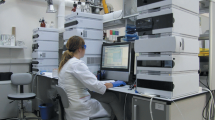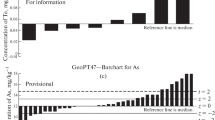Summary
Because of high labour costs, a prerequisite for economic running of an organic elemental analysis laboratory was the development of rapid methods for the most frequently determined elements, which in our case are N, C, H, O, halogens and S. The methods must be capable of automation to the fullest extent, and the analytical results available in the shortest possible time. The data must therefore be presented in digital form for processing by computer, which can (in a fully automated version) print out a complete analytical record. To avoid dependence on physical calibrations, the end-determination methods should yield physical values strictly proportional to the amount of substance. Titration or gas volume measurement seems to fulfil this condition most closely. The methods developed and used at BASF has been reported, along with some new techniques and modifications to apparatus. A crucial point is the possibility of automating the different methods of analysis, and the economics of different degrees of automation have been discussed.
Zusammenfassung
Voraussetzung für die aus Kostenersparnisgründen notwendige Automation elementaranalytischer Labors waren Schnellverfahren für die am häufigsten zu bestimmenden Elemente: in unserem Falle N, C, H, O, Halogene und Schwefel. Die Verfahren müssen weitestgehend automatisierbar sein und die Analysenwerte in möglichst kurzer Zeit zur Verfügung stehen. Die Einzelwerte müssen dabei in digitaler Form vorliegen, um in einem Rechner weiter verarbeitet und gegebenenfalls als vollständiges Analysenprotokoll ausgedruckt werden zu können.
Unsere prinzipielle Forderung für alle Verfahren war die völlige Unabhängigkeit der jeweiligen Endbestimmung von physikalischen Eichungen. Grundvoraussetzung war also eine strenge Linearität zwischen Menge und Meßwert. Diese schien uns am ehesten gewährleistet bei der Gasvolumetrie und der Titration.
Über die von uns in der BASF entwickelten und eingesetzten Verfahren zur Schnellbestimmung der genannten Elemente wurde im einzelnen berichtet und auf neuere methodische und apparative Modifikationen hingewiesen. Ein Schwerpunkt sollte dabei die Möglichkeit der Automation der verschiedenen Analysenverfahren sein. Auch die notwendige Wirtschaftlichkeit in Relation zum Grad der Automation wurde diskutiert.
Similar content being viewed by others
References
W. Merz, Z. analyt. Chem.237, 272 (1968).
W. Merz, GIT Fachzeitschrift für das Laboratorium1970, 617.
W. Merz, Intern. Laboratory1974, 29.
W. Merz, Talanta21, 481 (1974).
H. A. Staab, Angew. Chemie74, 407 (1962).
W. Merz, Analyt. Chim. Acta48, 381 (1969).
W. Merz, E. Brodkorb und M. Krauz, Mikrochim. Acta [Wien]1972, 939.
E. Brodkorb und H. Scherer, Ind. chim. Belge, Nr. Spez. I 32, 137 (1967), DBP 1279384; DBP 1291981.
W. Merz, GIT Fachzeitschrift für das Laboratorium1975, 293.
L. Büchs und W. Merz, Vom Wasser47, 267 (1976).
W. Merz, Intern. Laboratory1977, 49.
W. Merz und H. Kreutzer, Chemie-Technik6, 379 (1977).
W. Merz, Analyt. Chim. Acta50, 305 (1970).
W. Merz, Analyt. Chim. Acta53, 429 (1971).
W. Merz, Mikrochim. Acta [Wien]1971, 71.
W. Schöniger, Mikrochim. Acta [Wien]1955, 123;1956, 869.
C. Harzdorf, Z. analyt. Chem.215, 246 (1966).
J. S. Fritz und S. S. Yamamura, Analyt. Chemistry27, 1461 (1955).
Author information
Authors and Affiliations
Rights and permissions
About this article
Cite this article
Merz, W. Automated rapid methods in organic elemental analysis. Mikrochim Acta 70, 519–534 (1978). https://doi.org/10.1007/BF01197104
Received:
Issue Date:
DOI: https://doi.org/10.1007/BF01197104




